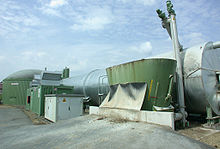
| Part of a series on |
| Sustainable energy |
|---|
 |
Biogas is a gaseous renewable energy source[1] produced from raw materials such as agricultural waste, manure, municipal waste, plant material, sewage, green waste, wastewater, and food waste. Biogas is produced by anaerobic digestion with anaerobic organisms or methanogens inside an anaerobic digester, biodigester or a bioreactor.[2][3]
The gas composition is primarily methane (CH
4) and carbon dioxide (CO
2) and may have small amounts of hydrogen sulfide (H
2S), moisture and siloxanes. The methane can be combusted or oxidized with oxygen. This energy release allows biogas to be used as a fuel; it can be used in fuel cells and for heating purpose, such as in cooking. It can also be used in a gas engine to convert the energy in the gas into electricity and heat.[4]
After removal of carbon dioxide and hydrogen sulfide it can be compressed in the same way as natural gas and used to power motor vehicles. In the United Kingdom, for example, biogas is estimated to have the potential to replace around 17% of vehicle fuel.[5] It qualifies for renewable energy subsidies in some parts of the world. Biogas can be cleaned and upgraded to natural gas standards, when it becomes bio-methane. Biogas is considered to be a renewable resource because its production-and-use cycle is continuous, and it generates no net carbon dioxide. From a carbon perspective, as much carbon dioxide is absorbed from the atmosphere in the growth of the primary bio-resource as is released, when the material is ultimately converted to energy.
- ^ National Non-Food Crops Centre. "NNFCC Renewable Fuels and Energy Factsheet: Anaerobic Digestion", Retrieved on 2011-02-16
- ^ Webdesign, Insyde. "How does biogas work?". www.simgas.com. Archived from the original on 10 May 2018. Retrieved 16 May 2018.
- ^ Mao, Chunlan; Feng, Yongzhong; Wang, Xiaojiao; Ren, Guangxin (2015). "Review on research achievements of biogas from anaerobic digestion". Renewable and Sustainable Energy Reviews. 45: 540–555. doi:10.1016/j.rser.2015.02.032.
- ^ "Biogas & Engines". clarke-energy.com. Retrieved 21 November 2011.
- ^ "Biomethane fueled vehicles the carbon neutral option". Claverton Energy Conference Bath, UK. 24 October 2009. Archived from the original on 31 May 2023.